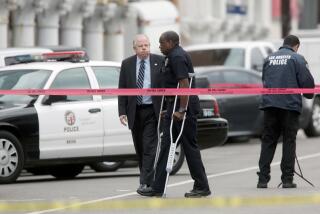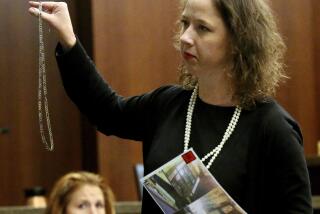Top Prosecutor Bryan Brown Resigns for Move to Civil Law : Lawyer: Assistant district attorney who handled William Bonin, Randy Kraft cases will join a friend’s private practice.
SANTA ANA — Bryan F. Brown, Orange County’s celebrated homicide prosecutor who won convictions of two of the state’s most notorious serial killers, announced his resignation Wednesday from the district attorney’s office, where he has spent his entire career.
Brown, who recently turned 50, will go into private practice with Newport Beach civil attorney Richard R. Farnell, a former prosecutor who was close to Brown when they were colleagues.
“I want to go out and represent people in society,” said Brown, who is a former California Prosecutor of the Year. “To be successful at (civil litigation) takes a certain number of years. Turning 50 made me realize I’d better get started.”
Brown, whose career has brought him close to victims’ families, will not leave office until Feb. 7, so he can complete his last capital case.
On Jan. 31, Robert (T-Bone) Taylor is scheduled to be sentenced to the gas chamber for the slaying in 1988 of Ryoko Hanano, 60. She was shot to death in the bedroom of her Anaheim home and left shackled to her husband, Kaz Hanano, who was shot and paralyzed. The couple had attracted the attention of Taylor and his two accomplices by advertising a Corvette for sale.
“I couldn’t leave office without seeing that through; I owe it to Mr. Hanano,” Brown said Wednesday in an interview.
Taylor will be the fifth county defendant placed on San Quentin’s Death Row by Brown’s tenacity as prosecutor.
He successfully prosecuted serial killers William George Bonin, in 1983 for four Orange County murders, and Randy Steven Kraft, in 1989 for 16 murders in the county.
Two others on Death Row prosecuted by Brown are John George Brown, in 1981-82, and Teofilo Medina, convicted in 1987 for a series of convenience store/gas station robberies.
Brown was named California Prosecutor of the Year in 1984, primarily for his work in the Bonin case.
Brown said both Bonin and Kraft stand out because of their many victims. Bonin was also convicted in Los Angeles of 10 murders and is accused of 24 in all. Kraft was convicted of 16 murders here and is accused of killing 65 people in Southern California, Oregon and Michigan. All of Bonin and Kraft’s victims were teen-age boys or young men.
“That’s 89 kids between these two,” Brown said. “It really stirs you to think about all the families affected.”
Brown said he plans to represent some crime victims now in civil cases. “I want to pick up where the criminal justice system leaves off,” he said.
Farnell said he has been after Brown for a long time to join him in private practice and expects Brown to concentrate on civil trial work.
“I can’t believe my good fortune,” Farnell said. “I can’t wait to see this guy in action on the civil side.”
Brown--gray-haired, tall and athletic enough that he still surfs and scuba-dives--is known to judges and defense lawyers not for flamboyance in the courtroom but for being low key, as if he were talking to each juror at a kitchen table over coffee. The only time he cried in front of a jury was when he described Ryoko Hanano praying in Japanese right up to the moment of her death.
Brown’s most difficult prosecution might not have been any of his death-sentence cases. In 1981, he prosecuted Santa Ana chiropractor Thomas Luparello for murder in a love triangle. But the trial judge threw out a key bit of evidence: that Luparello had been in a car with the killers at the time of the shooting. The victim was shot after refusing to tell them where Luparello’s former girlfriend had moved.
With that evidence gone, defense attorney Robert D. Chatterton was so surprised when the jury found his client guilty of first degree murder that he banged his head on the counsel table.
Brown pointed to one major disappointment in his 24 years as a prosecutor. It came when he tried to prosecute a Huntington Beach couple for first-degree murder in the beating death of their baby. The woman won acquittal, and the husband was found guilty of voluntary manslaughter.
“I knew from the beginning that case was a second (-degree murder), and I should have tried it that way,” Brown lamented Wednesday.
One of the most controversial cases was Brown’s bid to convict the three Slender brothers of murder in 1986. A dispute between the brothers and two sheriff’s deputies led to a fight in the driveway of their home near Tustin, in which the wife of one of the brothers was fatally shot by a deputy. The deputies said the brothers had resisted arrest when they tried to detain one of them on a traffic violation.
Brown thought the three brothers were responsible for the woman’s death. After a lengthy hearing, the three were bound over for trial in the murder.
Brown discovered later that authorities had inadvertently failed to turn over to the Slenders’ attorneys a deputy’s notes that differed sharply with his actual report. Charges against the Slenders were dismissed, and Brown’s later bid to revive the case failed.
“You learn more from the tough ones like that than the successes,” Brown said.
Santa Ana attorney Allan H. Stokke, who represented one of the Slenders and has faced Brown in court several times, disagrees that the case should have gone to trial. But he praised Brown for finally coming up with the notes.
Stokke said rumors about Brown’s leaving the office had been floating around legal circles for weeks.
Except for the Hanano case, Brown left trial work a year ago, when newly elected Dist. Atty. Michael R. Capizzi promoted him to assistant district attorney, which placed Brown in the office’s administrative hierarchy.
His resignation announcement Wednesday surprised many in his office but not his closest friends. “When he left courtroom work, it was just a matter of time until he left the office,” one former colleague said.
Brown said he has been thinking about resigning for months. “I had two bulls on each arm, pulling me in different directions,” Brown said. “It’s something I want to do.
“But the people in this office have been my family for almost half my life. A perfect family, for me.”
“Bryan is an extremely intelligent, resourceful, imaginative lawyer,” Stokke said. “He’ll be great in civil law. But he understands the system so well, I truly believe that even a Bryan Brown could represent criminal defendants if he wanted to.”
Brown is a graduate of the prestigious Hastings College of the Law in San Francisco. He joined the district attorney’s office in January, 1968, immediately after passing the bar. Since then he has refused many offers to leave for private practice.
Deputy Dist. Atty. Richard M. King, a veteran homicide prosecutor, was visibly moved by Brown’s announcement.
“We call him Dad here in homicide, and there’s a lot of meaning behind that,” King said. “Every prosecutor I know started out just like me: We all wanted to be Bryan Brown.”
Bryan Brown ‘Wing’ on Death Row
These criminals have been convicted by Orange County homicide prosecutor Bryan F. Brown during his career with the district attorney’s office:
William George Bonin
Convicted of strangling 14 boys whose nude bodies were dumped along Southern California roadways, earning him the nickname “Freeway Killer.”
Sentenced in Los Angeles County on Jan. 2, 1982, for 10 murders; and in Orange County on Aug. 26, 1983, for four murders.
John George Brown
Also known as Gordon Lee Mink, convicted in the June 7, 1980, murder of Garden Grove Police Officer Donald Reed, who was shot to death when he entered the Cripple Creek Saloon seeking to arrest Brown.
Sentenced June 11, 1982.
Teofilo Medina
Convicted of murdering two young men working at two Santa Ana gas stations and a third at a Garden Grove drive-through dairy during a three-week robbery spree in the fall of 1984, which took place soon after he was paroled on a rape conviction from an Arizona prison.
Sentenced Feb. 25, 1987.
Randy Steven Kraft
Convicted of 16 Orange County murders, and accused of 49 other murders in California, Oregon and Michigan. Kraft preyed upon young men, many of them Marines, whom he drugged, tortured and sexually mutilated.
Sentenced Nov. 29, 1989.
Robert (T-Bone) Taylor
Convicted of murdering Ryoko Hanano of Anaheim. Taylor shot Hanano to steal a 1984 Corvette advertised for sale for $20,000. Hanano was killed while she begged for mercy. Taylor then shot her husband, Kazumi, twice in the head. He survived, but was paralyzed.
To be sentenced Jan. 31, 1992.
Compiled by JANICE L. JONES / Los Angeles Times
More to Read
Sign up for Essential California
The most important California stories and recommendations in your inbox every morning.
You may occasionally receive promotional content from the Los Angeles Times.










